5590BA Battery Adapter
© Brooke Clarke 2005
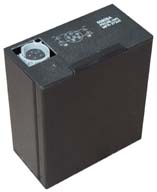 |
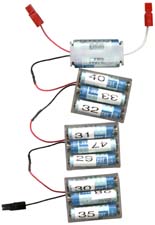
|
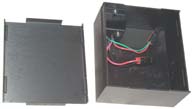
|
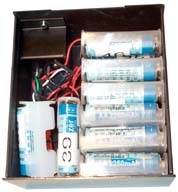
|
Top
|
1 of 2
Production Strings
holding 10 or 11 AA Cells
|
Lid
Open
Power Pole connectors
|
Box
with Battery Holders
6 ea 3 AA + 2 ea 2AA
20 * 2.3 * 1.2 = 55 WH
8 hours run time
|
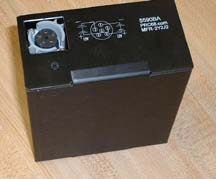
|
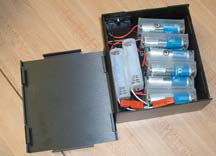
|
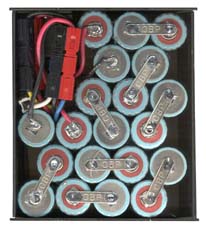
|
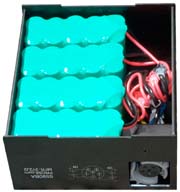 |
Top 3/4
view
|
Open
View
|
20 SC
cell hand made pack
|
4 Packs
of 10 ea Ni-MH
2.0 AH per pack
40 * 2.0 * 1.2 = 96 WH
10 hours run time |
Description
Universal Design
AA Cells in
Battery Holders
AA Packs
Li-polymer
possible
SC Pack
Discharge
Battery
Holder Tests
Charge
Socket
Assembly
10 or 11
Cells
Charging
Experiments
Use as Battery Eliminator
Testing
Fit
Internal Resistance
Load
Current
Capability -
Table
Run Time -
Table
Batteries Not Included
Recommendation
$ per Watt Hour
Weight
Opening the 5590BA
Status
Related Products
Plug
Background
Ordering
Description
Universal
Design
Note that the design that has
gone into production is the one I named "Universal" during the
design process. The label should have been "5590BA/U",
but it's too late for the first batch of adapters. The
reason for the Universal name has to do with the ability to
easily change what cells are installed.
AA Cells
The first version of the adapter will have custom made battery
holders for AA size rechargeable cells (batteries not
included).
It may be possible to use Alkaline AA cells for radios like
the SINCGARS that connect the two internal batteries in
parallel. More testing shortly on that using the strange
Everactive Wal-Mart AA Alkaline cells that have very low
internal resistance.
14 March 2006 - Note that a SINCGARS radio (PRC-119 manpack
version) will draw almost 4 amps and that's too much for the
battery holders. See the Current table (Prod, 3rd gen,
Hldr2) and note that the max current is 2.5 amps. For
high current applications a battery pack that does not use
springs is required.
AA Cell Pack
After testing a used BB-390 on
the ½ PRC-104 load cycle and getting just over 12 hours run
time and knowing that the 2.3 AH Ni-MH gives 8 hours it should
be possible to get 16 hours by using 40 each AA cells.
There's no way this can be done using battery holders, but it
is possible to get 40 AA cells into the box with room for the
wiring and connectors if it was as a battery pack. There
is a 2x5 pack of AA cells and four of them will just fit, see
right hand photo at top of page. This may have a
capacity similar to a used BB-390A/U.
Li-poly Possible
It should be possible to install 8 Kokam 3.27 AH Li-poly
pouches and a couple of 4 Lithium battery protection circuits
into the same box. These cells have a discharge rating
of 3*C (about 9 amps) but the protection circuits limit the
current to 6.5 amps (although there may be a way to change
that). Since Power Pole connectors are used on the back
of the adapter socket it's very easy to remove or swap the
battery packs.
SC Pack
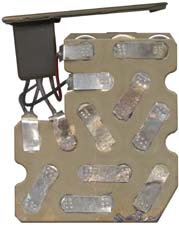
The BB-590
battery (shown at left) uses 20 each Sub C (SC) Ni-Cad cells
that have spot welded interconnecting straps. The cells
are held in a plastic two piece calm shell type housing that
provides a small amount of separation between cells.
Label has a 1983 date, 1.5 Amp Hour rating at 1.8 Amps.
So the 2005 SC size RC Ni-MH batteries will probably provide
more than twice the capacity. Even the 2.3 AH Ni-MH AA
cells should have more capacity. Can not test this one
since there are dead cells.
The label on a Ni-MH BB-390 with a 1995 contract date is rated
3.6 AH at 0.72 Amps. Note the AH rating will be much
lower at 1.8 Amps which is closer to a real radio Tx load
current.
These are the same type of cells used in the RC racing car
hobby. But since the RC motors draw currents in the tens
of amps they use
copper
bars to interconnect the cells both for lower resistance
and as a way to get heat out of the cells. They seem to
use only flat top SC cells, no other sizes so it's fortunate
that this is the cell size that fits the 5590BA.
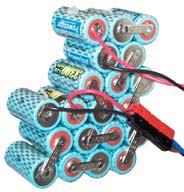
By
hot melt gluing the cells together the resulting pack will be
slightly smaller than the BB-590 pack shown in the photo above
left because the BB-590 has an air gap between cells.
After gluing the copper bars and wires are soldered.
The pack at left uses the same cell orientation as a BB-590
with the same cell polarity and wiring.
Although this 20 SC cell pack fits into the box, like the 4
each AA packs, it has the same problem with the lid
fitting. The tabs hit some cells preventing them from
seating. This can be fixed simply be filing the tabs so
that they protrude slightly less than 0.60" into the
box. This way the tabs will not go inside the box.
This works well making it much easier to remove the lid.
Using hot melt glue and cardboard (but not glued) as an
insulating spacer on the pack faces where the connecting bars
are located.
15 Nov 2005 Caution
- Some SC cells have a diameter of 0.9" (22.86 mm) and when
these are used to make a pack it will be too tall to fit
into the 5590BA. The 0.87" (22.1 mm) diameter cells will fit
with a little room to spare.
25 Nov 2006 - It should be possible to fit 23 mm diameter SC
cells by rearranging the right cell in the 4th row from the
bottom. Then the right cell in the 5th row up from the
bottom (only 2 cells in this row). Then the top two
cells.
Battery Space is now offering a 4.5 AH SC cells that has
specs similar to Li-Ion but for much less, see:
http://www.batteryspace.com/index.asp?PageAction=VIEWPROD&ProdID=2283
A theoretical calculation shows the maximum SC cell diameter
that will fit is 0.887" (22.5 mm) based on close packing
(which is the easy way). A better way is to position
the cells inside the battery box (with an insulator on the
bottom for safety) and use hot melt glue to tack them in
place. Then add all the jumpers and wires to make the
pack plus reinforce it with more hot melt glue.
12 Jan 2007 - If a 0.030" horizontal gap is inserted between
the 4 batteries in the bottom row (photo above and to the
left showing 20 SC cells) then there will be a 0.030
horizontal gap in all the batteries above the starting
row. This has the effect of making the battery pack
height fit the battery box when 0.920" diameter SC cells are
used.
Battery Eliminator
Another way to use the adapter is as an interface for a
battery eliminator. To do this a power supply (either a
dual "12 Volt" or a single "24 Volt" supply would be connected
to the back of the socket using Power Pole connectors and the
adapter plugged into a radio or other equipment.
Discharge
Since 2001 my main focus on this
product has been to come up with a reasonably priced battery
adapter that would work. By work I mean that the
discharge characteristics were good enough to power radios
that worked with the BA-5590 primary battery. Note the
BA-5590/U is not supposed to supply more than 2.25 Amps.
The key to getting good discharge performance is minimizing
the resistance of the batteries, springs and wiring.
The 5590BA Battery Adapter can be
used in most applications where the
BA-5590/U
or one of its derivatives (BA-390/U BA-590/U, BA-2290/U) is
used. The case is black anodized aluminum and there is a
removable lid to gain access to the interior. It uses the
secondary type battery socket that has gold plated contacts
providing longer life than the primary type battery socket.
5 wires from the socket are connected with a white power pole
connector on pin 3. Each battery pair from the socket is
terminated with
Power Pole
connectors. The first version will come with two strings of
AA battery holders. Each string will hold either 10 or 11
cells so that when rechargeable batteries (the only type
recommended) are used the voltage will be just under 15.0 Volts
(which is correct for a "
12 Volt"
battery).
14 Apr 2005 - using the latest Powerizer 2.3 AH AA batteries gives
an equivalent PRC-104 run time of 8 hours.
Charge
There is a potential problem if an
old fashioned DC fast charger, like the Maha C777+, is used on
Ni-MH cells. At the end of charge the battery will get very
hot, possibly damaging the plastic battery holders. But this
can be avoided by using a slow charge (current < C/10) or by
using a
burp mode charger, like
the
Propel BB-590. The
Propel charger makes the C777+ look like it was designed in the
stone ages and has changed my mind about allow the 5590BA to be
charged from the socket.
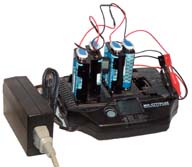 An old fashioned DC fast charger can be used by
charging each string out of the battery adapter. Note that the
Maha temperature sensor is sandwiched between two of the 3 AA
holders. The stock Maha clip leads work nicely with the Power
Pole connectors on the string of 10 or 11 cells.
An old fashioned DC fast charger can be used by
charging each string out of the battery adapter. Note that the
Maha temperature sensor is sandwiched between two of the 3 AA
holders. The stock Maha clip leads work nicely with the Power
Pole connectors on the string of 10 or 11 cells.
Ni-MH cells get very hot during the
charge cycle unlike Ni-Cad cells that don't get as hot. I
typically measure 140 degrees F at the end of a charging cycle for
Ni-MH cells where the batteries are out in open air.
Socket Assembly
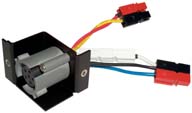
The socket used
on the 5590BA is what's called a secondary socket and it's
different from a primary socket in a number of ways. It has
a metal frame with a rubber insulating block holding gold plated
contacts. Whereas the primary socket uses a plastic frame
insulating block and non gold plated contacts. The warding
keys in the secondary socket are different from the keys in the
primary socket. This is one way that a device that can
charge a battery is prevented from charging a primary
battery. The aim of the secondary socket is to offer many
more mating cycles than would be the case with a primary socket
and that's why it's used on the 5590BA.
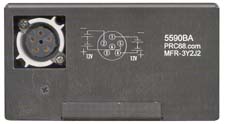
Top view showing the circuit diagram and labeling:
5590BA
PRC68.com
MFR-3Y2J2
Pin 3 is wired to pin 1 using white wire and white
Power Pole connectors. When mated they allow chargers or
radios that use pin 3 for charging (to prevent charging a primary
battery) to charge this adapter, and when separated they will
prevent pin 3 type chargers from charging this adapter. Note
that because a secondary socket is being used a charger that only
used the socket to prevent charging may try to charge this adapter
even when the pin 3 connection is open.
10 or 11 Cells for each "12 Volt" Battery
In my opinion it was a mistake to use only 10 cells in the BB-390
and BB-590 since using 11 cells gives an open circuit terminal
voltage just under 15.0 volts, which is what a fresh BA-5590/U
measures since it has 5 each 3.0 Volt LiSO
2 cells for
each side. But for this adapter the extra volt provided by
the eleventh cell provides more Watt Hours.
NOTE:
As
of 21 June 2005 I know of no fast charger that can charge
strings of 11 cells using the "Burp" method. This means
that in order to use 11 cells either use a slow charge or
disassembly of the adapter would be required. It may be
that there are chargers that can do it (maybe used in the RC
hobby) but so far none of them have answered technical
questions.
Charging Experiments
These experiments are being done on
a 5590BA that has pins 1 and 3 connected and using 20 cells (not
22) and with the starting dead battery voltage for the 20 cells
around 12 to 14 volts. The discharge cycle I'm calling "1/2
PRC-104" is using 100 ma for 9 minutes & 1.5 Amps for 1
minute, repeated until the battery voltage goes below 20
Volts. If two batteries are installed in the PRC-104
(connected in parallel) then the run time would be the same as for
this test. For more on battery chargers see the
Battery Charger web page.
Maha C777+ Charger
Batteries very hot at end of
charge and 3.8 hours run time. Should not be used to
charge the batteries while in the 5590BA because there's a
chance that the temperature sensor will be on one of the battery
holders that's not being charged they over heating the charged
battery holders and damaging them.
When a string of 11 brand new Ni-Cad cells were connected to the
Maha C777+ it stopped charging in about 15 minutes and said that
the batteries were charged. Reconnecting the next day had
the same result, i.e. after 18 minute the charger stopped and
said the batteries were full. Reconnecting a third time
allowed 994 mAH to be put in and it took 80 minutes. This
may confirm a claim in the Propel patent saying that Ni-Cads
that have been stored for a long time (or are new) have a false
voltage peak at turn on that fools most chargers.
After the 80 minute charge the batteries were warm (about 113
deg F) and the terminal voltage is 15.33 (1.39 volts/cell).
The Maha seems to use a 10 ms wide pulse 100 times per second to
change the charging current or discharging load by a small
amount as part of it's method of measuring the batteries being
charged. It does NOT use classical Burp Charging like the
Propel BB-590.
With 11 Ni-Cad cells on the Maha, when fully charged there is a
10 ms wide pulse on top of the DC charge that's at a rep rate of
99 Hz. The baseline voltage is 15.78 V ( 1.16 V/cell) and
the pulse peak is 18.70 V (1.7 V/cell).
TMQ-34 Charger
Leaving the 5590BA (with 20 Ni-MH
cells, not 22) on the Charger that comes with the
TMQ-34 Weather Station overnight
does not cause any heating. This is a trickle charger
(maybe 60 to 100 ma).
The PP-8444 charger will put
charge into the 5590BA. But since the 5590BA does not have
the built-in temperature sensor it will overheat. I tried
it with the 4 packs of 10 Ni-MH configuration and pulled it off
the charger. The adapter surface was at 110 deg F but the
internal packs were closer to 150 deg F. The battery pack
used in the
Tek 1502
Cable Test Set has heat spreaders to take the heat away
from each cell and if that were done here maybe the cells would
not get to as high a temperature.
To me this is a confirmation that Ni-MH needs temperature
sensors when conventional chargers are used. It's too bad
that burp chargers were not used or that there's not a burp
charging option for the PP-8444 charger.
This charger can
not
be used in a start it and leave mode. It needs constant
baby sitting to prevent overheating the batteries.
Lab Power Supply BK Precision Model 1786 30 V 3 A
First try CV=30.0 CC=0.25
amps. The C/10 rate would be 225 ma. The 1786 doesn't have
perfect CC mode resulting in 0.29 amps or C/7.7 current.
20 cells in series using the "charging cable" from
Steve Hanney.
0.25 amps at 27.0 volts 10:56 starting
0.29 amps at 28.2 volts 11:43 box cold
0.29 amps at 28.5 volts 12:42 box cold
0.29 amps at 28.8 volts 13:52 box cold
0.29 amps at 29.1 volts 14:32 box cold
0.29 amps at 28.7 volts 15:39 box slightly warm
0.29 amps at 28.1 volts 16:44 box warm
0.29 amps at 28.1 volts 17:44 box warm
0.29 amps at 28.1 volts 18.30 box warm
0.29 amps at 28.1 volts 20:00 box warm
4.8 hours of run time on the 1/2 PRC-106 test cycle. 24.7
Volts open ckt.
4.7 hours of run time on the 1/2 PRC-106 testy cycle when the
same pack was charged on the Propel charger.
So far this appears to be the best
way to charge a string of 20 Ni-MH or Ni-Cad cells. It
uses a couple of patented microcontrollers to be smart about the
charging. 6.2 hours run time in the 1/2 PRC-104 discharge
cycle.
Using 20 each 1.0 AH
Ni-Cad
cells the run time is 3.3 hours. If the 2.25 AH Ni-MH give
4.8 hours of run time then the 1.0 AH Ni-Cads should give 2.1
hours of run time. There may be two factors, the Ni-Cad
cells may be better at supplying the 1.5 amp transmit current
and/or the Ni-MH cells may have been degraded by charge
overheat. After another charge cycle on the Propel the run
time was 3.7 hours (5.3 AH delivered).
After charging on the Propel a second time the run for 20 Ni-MH
have a run time of 6.5 hours! 9.39 AH delivered, ending OCV
24.3 Battery numbers: 1, 2, 3, 5, 6, 7, 8, 9, 11, 12, 13,
14, 15, 16, 17, 18, 21, 22, 23, 24.
The other Ni-MH battery pack only delivers 4.8 hours of run time
(7 AH delivered).
The cell numbers for this pack are: 27, 28, 29, 30, 31, 32, 33,
34, 35, 36, 38, 39, 40, 41, 42, 43, 44, 45, 46, 47. Why
the difference in capacity, could it be that the overheating on
the Maha C777+ degraded a pack?
Got some new Powerizer Ni-MH cells rated at 2.3 AH and after a
few hours on the Propel they are around 100 deg F, warm, not
hot. I'll let these trickle charge overnight and run the
PRC-104 load test tomorrow. These cells have NOT be on the
Maha charger.
14.20 Volts Open Circuit for 10 cells after some trickle charge,
i.e. 1.42 Volts per cell or 28.4 Volts for a string of 20 cells.
Run time 8 hours, 11.6 AH delivered. Ending OCV 23.5. The
2.25 AH should deliver (2.25/2.3 * 8 = 6) 6 AH, so the 2.25 AH
pack that's delivering only 4.5 hours was damaged by
overheating. The 2.25 AH pack delivering 6.9 hours is OK.
The Propel seems to charge 22 cells correctly, but need to wait
untill this afternoon to see what the run time is. Only
7.8 hours, 20 cells run for 8 hours so this did not work.
This charger has a switch to
select either 0.9 Amp(<2.1 AH Batt) or 1.8 Amp (>2.1AH
Batt) charge current and includes
Burp
charging. It takes very close to 2 hours to charge 10
3.3 AH SC cells (1.8 Amps * 2 hours = 3.6 AH). The cell
temperature gets warm but not hot. Since these don't
cost that much <$30) it would make sense to use two of them
in parallel to charge the 20 cells in a 5590BA.
Data taken during charging left for side A and right for side
B:
Time
|
Temp
(F)
|
Voltage
|
|
Time
|
Temp
|
Voltage
|
7:16
|
-
|
12.7
OCV
|
|
9:22
|
-
|
12.77
OCV
|
7:17
|
77.6
|
12.9
|
|
9:23 |
77.8 |
12.94 |
7:41
|
78.6
|
13.91
|
|
9:43
|
85.5
|
13.85
|
8:26
|
81.7
|
14.14
|
|
10:09
|
88.6
|
13.81
|
8:53
|
82.5
|
14.40
|
|
10:20
|
89.6
|
14.04
|
9:17
|
99.4
|
14.45
|
|
10:55
|
93.6
|
14.25
|
9:22
|
100.8
|
14.161
|
|
11:10
|
95.1
|
14.36
|
|
|
|
|
11:16
|
105.3
|
14.36
|
|
|
|
|
11:23
|
112
|
14.131
|
Note
1 - you
can see the battery voltage has a negative delta V that's
detected by the charger to switch to trickle charge mode
properly before the batteries overheat from excessive
charge. I was not paying a lot of attention to when the
fast charge LED (red) changed to trickle (green) so the actual
times are probably a little shorter than shown above.
The charged battery was allowed to sit overnight then in the
morning was reconnected to the charger which ran for maybe 10
minutes for each string of 10 cells then went into trickle
charge. Now on the 1/2 PRC-104 run time test with an OCV
of just over 28 volts. the 12.5 hour run time is the same as the
12.75 hour run time from the Propel BB-590. Will try a
SINCGARS run time test, but expect it will be in line with the
Propel charger also. The Battery Space charger looks like
a good way to charge the SC cells. Need to check it on the
2.3 AH AA cells.
3 May 2005 - have a 5590BA with 22
each 2.3 AH Ni-MH Powerizer cells on the charger. Set for
C/10 (239 ma) and 16 hours. Will measure run time
tomorrow. Expect about 8.8 hours, but only got 8.25 hours,
just a tiny bit longer than 20 cells.
Have just got a
VRC-87 going and
need to modify the PP-8249 to reduce it's charging
current. As received the PP-8249 had the charging wire
disconnected making it the same as a CY-8644 Battery Tray.
When charging the current is over 400 ma, a little too high for
trickle charging a 5590 type battery.
Use as Battery Eliminator
A battery eliminator is a way to
use the AC power grid to replace a battery. Since the
5590BA uses standard Power Pole PP15 connectors on the inside of
the socket it's very easy to connect these to:
Where the radios supply voltage is known
Either a single 24 VDC supply, a single 12 VDC supply
Where the radios supply voltage is not known
A pair of "12 VDC" supplies. These are very common and are
used to replace a car "12 Volt" cigarette lighter socket or to
power "12 Volt" equipment
Note: For most radios "12
VDC" really means 10 to 15 VDC.
In the case of the SINCGARS CY-8523() battery boxes it's a
simple matter to remove two screws from the lid hinge to
seperate the lid from the rest of the battery box allowing the
5590BA to be installed without it's lid. and providing easy
access to the power pole connectors. A spacer should be placed
behind the 5590BA to prevent it from unplugging from the battery
box. By using an existing battery box a large amount of
money is saved and either the two terminal wire line interface
or the remote control handset is supported.
In a similar fashion the 5590BA can be used as the adapter
portion of a battery eliminator. This is a great way to
save money when a radio is being used where there is an AC mains
supply.
Testing
Fit
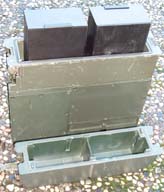
Two each 5590BA power the
PRC-104. Checked antenna tuning on
various bands and no low battery tone when speaking, like would
happen with one of the old style batteries.
The CY-7875/PRC-104 Battery Box has the battery plugs of if a
defective battery that does not have a floating socket breaks the
plug only the battery box gets damaged, not the radio.
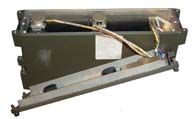
In the PRC-215
the battery compartment nearest the electronics is a tight fit but
the other is a good fit. This is a problem with the battery
box, not the 5590BA adapters. To remove the adapter closest
to the electronics the box needs to be turned over and bumped
against your hand.
The battery plugs are on cables so no need for a floating battery
socket.

The
SINCGARS -
CY-8523A battery box and the 5590BA
Battery Adapter.
The battery box has the battery plug thus protecting the radio
from a defective battery.
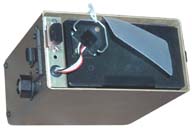
The 5590BA fits nicely into the LST-5 battery box. It can be
removed just by unplugging the connector and turning the box
upside down. If the plastic pull tab is folded over and then
the 5590BA is installed the extra thickness of the pull tab will
cause the 5590BA to be trapped such that is does not fall out when
the box is inverted. But it will come out if upside down and
jerked.
The battery plug is on a cable and so not sensitive to a non
floating battery socket.
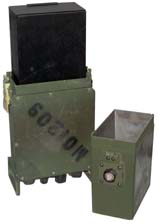
The HYX-57 and
KY-57 use the same
battery box. The 5590BA fits and functions fine.
The battery plug is on the KY-57 and HYX-57 and so it's important
that the battery socket floats.
Testing Internal Resistance
Using the modified capacitor ESR meter and modified probe the AC
resistance of a string of batteries can
be measured.
What
|
Where
|
Ohms
|
5590BA
10 ea 2.3 AH Ni-MH
charged or discharged
|
pins 1
to 4
or
pins 2 to 5
|
1.3
1.3
|
5590BA
10 ea 2.3 AH Ni-MH
charged
|
pins 1
to 4
or
pins 2 to 5 |
1.2
1.2
|
BA-5590
LiSO2
|
pins 1
to 4
or
pins 2 to 5 |
8.41
8.4
|
BB-557
Ni-Cad
|
pins 1
to 4
or
pins 2 to 5 |
0.36
0.38
|
11 ea 1
AH
Ni-Cad
disty batt hldr
|
Power
Pole
|
2.22
|
11 ea 1
AH
Ni-Cad
prod batt hldr |
Power
Pole |
1.53
|
10 ea
2.25 AH
Ni-MH
prod batt hldr
|
Power
Pole |
1.4
|
Note
1 - Something wrong, maybe has to do with circuit
inside BA-5590.
Note
2 - The stock disty battery holder is 1 Ohm higher
than custom battery holder.
Note
3 -same NiCad cells moved from disty batt hldr to
prod batt hldr.
AA Cell
| What |
Ohms
|
Duracell
Alkaline MN1500
|
0.54
|
Powerizer
#14
2.25 AH Ni-MH
|
0.04
|
Powerizer
2.3 AH Ni-MH
|
0.005 ?4
|
Kirkland
AA
Alkaline
|
0.12
|
Wal-Mart
EverActive
AA
Alkaline
|
0.04
|
Energizer
E91
Alkaline
|
0.06
|
Energizer
LS91
Li-FeS2 |
0.13
|
Note
4 - alternate 0.00 or 0.01 display
20 each Wal-Mart EverActive Alkaline AA batteries in series.
(under $ 8)) Eveready patents on Wal-Mart package:
6022639
Zinc anode for an electochemical cell Feb 8, 2000 429/229 (15.6
amp short ckt curr ? batt size)
6589693
High discharge electrolytic manganese dioxide and an electrode and
alkaline cell incorporating the same July 8, 2003 429/224;
429/218.1; 429/229; 429/231.8
These patents are aimed at providing high discharge currents and
are a big improvement over conventional Alkaline cells.
Load Testing
Current Capability
Battery Holder Tests
A test of some new custom made
battery holders done 27 Feb. 2005. The old holder was
tested first and the batteries moved to the new holder without
charging, so the starting voltage for the new holder is a little
lower than for the old holder. Once the voltage in this
test falls below 10.0 the radio will cut off and no longer work.
Measured Voltage vs. Load Current
Current
|
Production
3rd gen
Hldr1
|
Prod
3rd gen
Hldr2
|
Prod
3rd gen
Hldr2
|
Sample
2nd gen
Hldr
|
Disty
stock
Hldr
|
BB-390
used
|
4x10
2.0 AH
40 cells
|
Wal-Mart
"12 Volt"
SINCGARS
|
Wal-Mart
"24 Volt"
|
2 packs
10 SC cells
3.3 AH
|
BA-5590/U
|
BB-390
s/n..63
3.6 AH
|
BB-390
s/n..9U
3.6 AH
|
Chem:
|
Ni-MH
|
Alkaline
|
Alkaline |
Ni-MH |
Ni-MH |
Ni-MH
|
Ni-MH
|
Alkaline
|
Alkaline |
Ni-MH
|
LiSO2 |
Ni-MH
|
Ni-MH
|
#
Cells:
|
11
|
11
|
10
|
11
|
11
|
40
|
40
|
20
|
20
|
20
|
10
|
20
|
20
|
RI3
|
1.5
|
2.62
|
2.1
|
1.3
|
2.6
|
0.67
|
0.61
|
1.2
|
5.2
|
0.35
|
1.4
|
0.65
|
0.73
|
| Amps |
Volts |
Volts
|
Volts |
Volts
|
Volts
|
Volts
|
Volts
|
Volts
|
Volts |
Volts
|
Volts |
Volts |
Volts |
0.1
|
14.4
|
17.2
|
15.1
|
14.7
|
14.8 |
26.3
|
27.4
|
15.6
|
30.8
|
27.83
|
27.2
|
27.6
|
28.1
|
1.0
|
13.1
|
14.3
|
13.3
|
13.6
|
12.3 |
25.8
|
27.2
|
14.5
|
26.3
|
27.57
|
25.1
|
27.1
|
27.6
|
1.5
|
12.4
|
12.2
|
12.2
|
13.0
|
10.8 |
25.5
|
27.1
|
14.0
|
23.6
|
27.44
|
24.8
|
26.8
|
27.3
|
2.0
|
11.6
|
10.7
|
11.1
|
12.3
|
9.6 |
25.2
|
26.5
|
13.3
|
21*
|
27.27
|
24.3
|
26.5
|
26.9
|
2.5
|
10.9
|
9.7
|
10.9*
|
11.7
|
8.5* |
24.8
|
26.1
|
12.8
|
-
|
27.07
|
23.8*
|
26.2
|
26.5
|
3.0
|
10.2
|
8.7
|
8.9
|
11.0
|
-
|
24.4
|
25.8
|
12.2
|
-
|
26.8
|
|
25.9
|
26.1
|
3.5
|
9.4
|
7.8
|
7.9
|
10.3
|
-
|
24.2
|
25.4
|
11.6
|
-
|
26.7
|
|
25.6
|
25.7
|
4.0
|
8.6*
|
6.9*
|
6.8
|
9.5*
|
-
|
23.8
|
25.1
|
11.1
|
-
|
26.5
|
|
25.3
|
25.4
|
4.5
|
-
|
-
|
-
|
-
|
-
|
23.4
|
24.8
|
10.4*
|
-
|
26.3
|
|
24.8
|
25.0
|
5.0
|
-
|
-
|
-
|
-
|
-
|
23.0*
|
24.4*
|
-
|
-
|
26.1*
|
|
24.4*
|
24.5*
|
*PwrPk
|
68
|
56
|
54
|
56
|
42
|
115
|
122
|
47
|
42
|
130
|
59.5
|
122
|
122
|
Note
1 The new holder test was done using different
batteries. Need to do more controlled testing.
Note
2 The voltage is dropping fast with alkaline cells
so it's difficult to say what it really is. They can only
maintain the current for a few seconds, but might be useful.
Note
3 - DC Resistance. When multiplied by the Tx
current gives the voltage drop from the terminal voltage of the
battry. For example a fresh 20 Ni-MH cell battery might have
a terminal voltage of 28 volts. With a transmit current of
1.5 amps the drop will vary between 0.5 ( 27.5 delivered) volts
for the 20 SC pack to 3.9 (24.1 delivered) volts for a battery
using stock AA battery holders. There's 30% more power
delivered by the low resistnace pack.
* The peak power delivered for those tests where the peak power is
at 5 amps will be higher if more current is drawn. I just
was not comfortable using higher test currents. Note that
the home made 3.3 AH SC pack is delivering more power than any
other battery tested and it has the lowest DC resistance.
Note that the new holders are much much better than the stock
holders. Some radios, like the PRC-104, need a minimum of
20.0 volts to work. You can see from the above table that if
two of the old style battery holders were connected is series you
could get a little less than 2 amps at 20 volts out. BUT
with the new holders you can pull over 3.5 amps and still have 20
volts out of a single battery, not two batteries as are needed
with a stock BA-5590.
25 Mar 2005 - 11 Alkaline cells are a little hot (greater than 15
volts) and so are the
LS91 Li-FeS
2
Lithium cells.
6 May 2005 - for SINCGARS radios where the cells are paralled
alkaline and/or Li-FeS
2 may work.
Run Time
This is done using a lap top
computer to control an
electronic load.
The cycle uses 9 minutes of receive current and 1 minute of
transmit current.
Since the PRC-104 uses two batteries the actual currents are
deivded by two yeilding 100 ma Rx and 1.5 Amp test currents for
the actual 200 ma Rx current and 3 Amp Tx current.
SINCGARS uses a single battery with 320ma Rx current and 1.7
Amps Tx current for the Medium power setting.
The
Battery
Safety
Guide has some run times for the BA-5590/U.
PRC-104 23 hours normal temp, 7 hours low temp.
PRC-119 (RT-1439) SINCGARS 16 hours normal temp, 6 hours low
temp.
PRC-119A (RT-1523, RT-1523A) SINCGARS 25 hours normal temp, 16
hours low temp.
C-11561 SINCGARS RCU normal use 13 hours, 8 hours low temp
HYX-57 wire line interface 49 hours, 21 hr cold
KY-57 42 hr, 17 hs cold.
The Feb 2001 issue 579 pg 48 of PS magazine says a new BB-390A
battery will only give 6 hours of run time out of the box
after a charge, but that after two full charge discharge cycles
it should provide 12 to 18 hours of run time. The CECOM
web site for
rechargable
batteries says that a BB-390 near it's end of life should
deliver 8 hours of run time.
The 1999 PS mag issue 558 pg 53 says a BA-5590A/U will last 24
hours as part of the BB-390A/U promotion.
Actual Tested Run Times using laptop and
electronic load
Name
|
# of
Cells
|
Chemistry
|
AH
|
½
PRC-104
|
PRC-104
single batt
|
SINCGARS
|
5590BA
|
20
|
Ni-MH
|
2.3
|
8 hr
|
|
8 hr
4.7 hr5
6.8 hrs6
|
5590BA
|
40
|
Ni-MH
Pack
|
2.0
|
10 hr
|
|
7.8,
12.33
hr |
5590BA
|
20
|
Ni-MH
Pack
|
2.0
|
tbd
|
|
tbd
|
5590BA
|
20
|
Ni-Cad
|
1.0
|
3.5 hrs6 |
|
3.9 hrs6 |
5590BA
|
20
|
Alkaline
Wal-Mart
EverActive
same as
Eveready E91
|
2.0
|
tbd
|
|
2 hr2
|
5590BA
|
20 SC
|
Ni-MH
|
3.3
|
10.51 12.75
12.5 hr5
|
5.8
|
13,
9.8, 12.54 hr
10.6 hr5
9 hr6.5
|
BB-390
(9U)
|
40
|
Ni-MH
|
3.6
|
12 hr
|
|
8.5,
13.8 hr
|
BB-390
(63)
|
40
|
Ni-MH |
3.6 |
|
7 hr |
14.4 hr
|
Note
1 - First
run with SC pack 1 June 2005 - will do SINCGARS run next then try
PRC-104 again. (i.e. cycle pack a few times to get full cpacity.
The Battery Space AH ratings have no details and so don't mean too
much. But the capacity can be calculated for the radio cycle
loading.
The receive part of the cycle is: 9/60 hours * 1.2 Volts * 20
cells = 0.36 WH
The trans. part of the cycle is: 1/60 hours * 1.2
Volts * 20 cells = 0.60 WH
So the total for 10 minutes is 0.96 WH. An 8 hour run time
corresponds to 46 WH (divide by 1.2 V=) 38 AH. This is less
than the (20 * 3.3 AH) 66 AH capacity advertised for a couple of
reasons. The actual power delivered is not at 1.2 volts but
in all cases at a higher voltage that changes during the
test. The WH capacity of a battery decreases as the load
current increases, it's not constant. 1.5 Amps is much more
that the specified load current which is probably more like 0.33
Amps (i.e. C/10).
The SC pack (79 WH rating) is delivering more run time than the
higher rated 4 pack ( 96 WH) of 2 AH AA cells. This may be
because the SC cells are rated for much higher currents (say 30
amps for an RC race car) than the AA cells and so when loaded have
less internal voltage drop. Also the radio Tx currents are
about C/2 for the SC cell but more like C/1.3 for the AA cells,
i.e. the AA cells are called on to provide a higher discharge rate
relative to their capacity. Or maybe when two packs of 10
cells are connected in parallel they are not as efficient as a
pure series pack? Testing single packs of 10 will give some
insight on this.
4 June 2005 - the second PRC-104 run with the 20 SC pack improved
from the initial 7.8 hours to 12.75 hours, slightly better than
the used BB-390. Next another charge cycle on the Propel
then another SINCGARS run.
Note
2 - After the test the
batteries check as good on a radio shack battery tester, i.e..
they look like new, so the test terminated for an unknown reason,
maybe they got hot or gained charge after resting for a day or so.
Note
3 - after
being connected as a pack and going through a second charge cycle
the pack is now delivering more watt hours than any other option
tested as of 29 May 2005.
Note
4 - 6 June 2005 Second
SINCGARS run at 9.8 hours is strange. 13 June 2005 12.5 hours,
Propel Charger.
Note
5 - this
test after using the Battery Space charger
Note
6 - after
Propel Charger,
6.5
- after Proper Charger + 5 hrs on PP-7286 @ C/10
Batteries Not Included
The 5590BA comes with battery
holders for 22 AA batteries, but the batteries are not
included. I recommend the use of Ni-MH AA batteries. Ni-Cad
would also work but they have less capacity and may have memory
problems. A possible advantage of Ni-Cad batteries is that
they do not get as hot during charging and might work in military
chargers, but I don't have a way to check this out for all
situations. Some alkaline batteries have a lot of internal
resistance and so probably will not work at all, but this needs to
be checked once the custom production battery holders arrive.
You will also need to supply a battery charger that can charge the
batteries, either one at a time, or more conveniently charge a
string of 11 cells or even better the whole battery adapter if
it's a
burp charger that will not
overheat the batteries and holders.
For testing I'm using the 2.3 AH Powerizer AA batteries from
Battery Space. They come in a
24
pack for $29.99 and if discount code
batteryspace
is entered there's a 5% discount. They seem to be in stock
and ship the next day.
If you find a reasonable priced higher capacity AA cell let me
know.
Recommendation
The home made pack of 20 SC Ni-MH
cells gives performance about the same as a BB-390. Maybe
better depending on the Amp Hour capacity of the cells
used. This makes a great battery. The caution is
that you need either a burp or trickle charger. Don't use
the PP-8444 or Maha chargers as they will over heat the battery.
I have a pdf instruction sheet
with details on:
- how to Modify the Lid
- build the 20 cell SC pack
- Charger Recomendations (on this web page)
It's 8 MB, too big to email, will be sent USPS mail upon
request.
Battery Configuration
The battery holders that come with the 5590BA will provide good
service, but no where near the run times that you can get from
using SC size Ni-MH cells made up into a custom pack of 20
cells. There's a trade off between getting the highest Amp
Hour capacity cells for top dollar or getting slightly less
capacity for a better $/Watt Hour value. Today (10 June
'05) I think the 3.3 AH batteries from Battery Space are a
better value, but the 3.7 AH cells from
Cheap Battery Packs
have more capacity.
Charging
For either the Battery holders or the SC cells the charger (or
better 2 of them) from Battery Space appears to be good value
and does not overheat the cells like the Maha C777+ or the
PP-8444.
Fair Radio has some BA-5590 style plugs mounted on a metal plate
that can be used to make up a charger based on two of the
Battery Space chargers thus allowing both sides to be charged at
the same time. Much more convenient than doing them one at
a time. Also with two chargers both sides can be left on
trickle charge which may be needed to fully charge Ni-MH cells.
$ per Watt Hour
A comparison done 26 May 2005 all
for a 20 or 40 cell arrangement.
Source
|
Chemistry
|
Size
|
AH0
|
$/QTY
|
WH
|
$/WH
|
Battery
Space
|
Ni-MH
|
AA
|
2.3
|
$30 /
24
|
55.2
|
0.451
|
Battery
Space
|
Ni-MH
|
SC
|
3.3
|
$50 /
20
|
80.5
|
0.612
|
Cheap
Battery Packs
|
Ni-MH
|
SC
|
3.7
|
$130
/ 20
|
88.8
|
1.462
|
Battery
Space
|
Ni-MH
|
AA
|
2.0
|
$59 /
4 *10-packs
|
96
|
0.63
|
| Battery
Space
|
Ni-MH
|
AA |
2.0
|
$30 /
2 * 10-packs
|
48
|
0.63
|
Note
0 - The Amp Hour rating may or may not
correlate to radio run time. This is because the battery
voltage recovers when the load is removed or reduced. It
may be that the larger SC cells that are rated for 30 Amps load
current will actually provide a longer run time than the ratio
of the Amp Hour ratings.
Note
1 - There will be 4 left over batteries,
shipping costs need to be added.
Note
2 - This is the loose cell price. 20 bars
at 40 cents, some wire and connectors plus labor needed to make
pack.
Weight
The adapter without any batteries
installed weighs just under a pound.
Opening the 5590BA
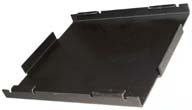
The aluminum lid has 4 "ears" that point inward and attach to 4
slots in the aluminum box. To get the "ears" clear of the
box pressure is needed on the two sides of the box. The
sides are 2.5" x 5". Since the socket bracket holds one of
the sides most of the pressure needs to be applied to the side
opposite the socket. This way no extra hardware is
used.
The prototype units take some force to open, a slight of build
person may want to use a vise with cloth covering the jaws to
squeeze the sides. The production units will be made from
thinner Aluminum and be easier to open.
10 June 2005 - By filing all the tabs so that the height measured
from the outside of the lid is reduced from 0.20" to just under
0.120" the tabs will not protrude into the inside of the box
allowing the use of 20 SC cells. It also makes it easier to
remove the lid.
Status
28 Feb. 2005 - It looks like the
prototypes work well. There may be a problem with how much
the socket floats. Need to get parts on order to build them.
2 March 2005 - I'm getting a quotation for a tapped battery holder
that would allow connection with either 10 or 11 cells in the
string. 10 may be needed for compatibility with military
equipment designed to charge the BB-590/U battery. Note that
the BB-390/U charger needs thermistors which are not part of the
current 5590BA design.
7 Mar 2005 - the battery holder manufacturer will supply my
improved design with the heavier wires
16 March 2005 - I've learned that one of the differences between a
primary socket (like used on the BA-5590) and a secondary socket
(like used on any of the BB-xx90 batteries) is that the warding
key ways are different. This is how the problem of charging
a BA-5590 is prevented. For some reason most chargers do not
check for the electrical jumper between pins 3 and 1. But
equipment that can charge the battery may use pin 3 as the
negative end of a 30 volt charger where pin 4 is jumpered to pin 2
and pin 5 is the positive end of the charger output. This
way a BA-5590 would not be charged.
25 March 2005 - Battery holders have arrived, but the 5590BA boxes
are back at the sheet metal shop for rework.
1 April 2005 - Received reworked boxes.
6 April 2005 - Doing charging tests to help determine how the
socket should be wired.
8 April 2005 - Starting prototype socket wiring with 105 deg
C wire and white Power Pole pin 3 charging option.
13 April 2005 - Received new 2.3 AH Powerizer AA cells for load
testing without being on the Maha charger.
Boxes out for laser
marking.
14 April 2005 - Run time of 8 hours using 20 each 2.3 AH
Ni-MH
Powerizer batteries.
19 April 2005 - Starting to test
Internal
Resistance of batteries + Battery Holders.
22 April 2005 - Boxes back with laser marking, see above.
Start
Pilot Production tomorrow
25 April 2005 - The machine shop can make the plug body to mate
with any BA-5590 family battery or this adapter. The plug
will use standard insert male pins and a standard 12 series clamp
(& bushing if the wire is that small). This will support
a number of
Related Products and also be
available for easy field assembly of cables without any potting
required. Small quantity of pins on order for the 5590P Plug
for testing.
2 May 2005 - The Propel charger seems to properly charge the
5590BA with 22 cells. Only 7.8 hrs run time, did not work.
3 May 2005 - 22 cell version of 5590BA on PP-7286 charger, more
tomorrow.
4 May 2005 - Only got 8.25 hours from 22 cells and using the
PP-7286 charger.
6 May 2005 -
MRCG
meeting Friday 10:00 am presentation of BA-5590 family and this
adapter,
Camp
San Luis Obispo
7 May 2005 - email to battery pack maker to see about a 40 AA cell
pack to fit the 5590BA.
8 May 2005 - Ordered 4 each
12
Volt
battery packs each one has 2x5 2.0 AH AA cells with welded
tabs and shrink wrap. They should fit the box as is.
Only need Power Pole connectors added
10 May 2005 - 4 Powerizer battery packs installed, they do fit
beside socket. Now on Propel charger.
11 May 2005 - the 40 cell (4 pack) run time is just over 10 hours,
not as good as a used BB-390 but very close.
Note although the 4 packs do fit
in the box the fit is so close that the lid can not be put
on. A design change would accommodate getting the lid on
but it's not possible now.
Wal-Mart Alkaline now on load test in SINCGARS "12 Volt"
configuration. Impressive current capability. 2
hours run time, they work but not for long (other alkaline cells
will not work at call at the high currents needed). Note
the Wal-Mart EverActive are about the same as Eveready E91.
23 May 2005 - Charging 2.3 AH Ni-MH and 1 AH Ni-Cad for SINCGARS
run time tests tomorrow. Then Ni-Cad charged by
PP-8444.
The 5590BA can be purchased with
customization options like without the AA battery holders or with
just wires from the socket with out Power Pole connectors or with
just raw connector pins so you can attach your own wires.
26 May 2005 - the SINCGARS run time
for 20 ea. 2.3 AH AA cells was a little over 2 hours. Not
sure why, but expect it has to do with matching the two strings of
cells.
Have 20 each SC 3.3
AH Ni-MH cells and some interconnect bars on order to make up a
20 cell pack. The cells will be hot melt glued together
then the interconnect bars soldered.
31 May 2005 - The 20 SC 3.3 AH batteries arrived. They came
with welded tabs, but both tabs are pointing in the same direction
so could only be used if you were making a stick. I bent
them back and forth and broke them all off. After sanding
the tab material it can easily be soldered. First used hot
melt glue to stick all the cells together then soldered on the
Cheap Battery Pack bars. The voltage as delivered on both
packs was a little above 12 V and matched to within 0.01
volts. As the Propel charger is charging both sides the
voltage continues to be within 0.01 volts. (note the cells
are sold as matches sets of 10 and I asked that both sets also
match each other. They will be charging overnight.
I also got the
Multi
Current
Universal Smart Charger that has a switch for either 0.9 or
1.8 Amps charge current (< $30). It should be able to
charge a 10 cell string without getting it hot, we'll see.
If that works well I'll get another so both sides can be charged
at the same time.
4 June 2005 - the 20 SC pack is looking better and better. A
drawing of the batteries in the box shows that the lid and slots
can be relocated so that although asymmetrical the lid can be put
on either way. Also have started looking into how to make a
battery holder for these cells that can handle the high currents
(i.e. have very low resistance).
6 June 2005 - 20 SC pack 9.8 hours run time on SINCGARS.
Next try Battery Space charger (10.6 hours).
7 June 2005 - the Battery Space charger works without
overheating the 3.3 AH SC cells,
see
above for details. The run time is the same as for the
Propel chrager so it works and is available. The alligator
clips that come with the charger work well on the Power Pole
connector on the batteries.
The first way I've come up with to make a battery holder for SC
cells is doable, but would be expensive. It's questionable
if it makes sense since it's relatively easy to solder up a pack
using readily available bars. The battery plug looks like a
more profitable product.
8 June 2005 - The Battery Space charger works nicely on the 2.3 AH
AA Ni-MH cells just over 100 deg F at end of charge, but takes
about 3 hours which seems a little long since the 3.3 AH SC
battery packs charged in 2 hours. 20 of the 2.3 AH AA cells
in battery holders are now on the SINCGARS run time test after
being charged with the Battery Space charger.
10 June 2005 - Lid
modification to allow use
of 20 each SC size cells and to make it easier to remove the
lid. Hint: If you haven't made this mod and are having
difficulty in removing the lid a small (-) blade screwdriver can
be used to pry it off.
28 June 2005 - Using a single 5590BA with a 20 SC cell pack the
PRC-104 will run for 5.8 hours. This is due to the very low
resistance of the SC pack keeping the voltage up during transmit.
16 July 2005 - A customer attempted to make the SC battery pack
and destroyed most of the cells by overheating them. So it
does take advanced soldering skills to make the SC pack. An
alternate would be to have a custom pack welded (or better bars
soldered) by Cheap Battery Packs.com or one of the "battery
stores" that does re-cell work or makes custom battery
packs. A simple way to test a pack is to connect a 12 volt
automobile tail light bulb to 1 & 4 or 2 & 5 to provide
some load current then check the voltage across each cell.
They all should be close to the same voltage and above 1.2
volts. To have bars soldered you need to go to someone who
makes packs for the RC car hobby. Normal battery dealers
only do the spot welding type packs.
17 July 2005 - Reduced price for U.S. mail address to under $100.
21 July 2005 - a used BB-390 on the full power PRC-104 run time
test lasts 7 hours compared to the 20 SC pack in the 5590BA at 5.8
hours.
Related Products
Plug
I have investigated a number of sources for plugs that mate with
the BA-5590 family of batteries and they are either very expensive
or difficult to use (require potting for cable attachment).
In order to offer the following cables a plug is needed. One
is now in the design stages. It will be a custom machined
shell-insert that will accept standard machined solder cup pins
and use a standard military size 6 cable clamp (3/4-20
thread). It also will accept a commercial low cost
extraction tool to allow the pins to be removed supporting rework,
repair or cannibalization (you can not do this with a potted
connector). The rear cavity is much longer than an ordinary
connector to allow a couple of 3 Amp Schottky diodes to be
installed in that space allowing the construction of a "12 Volt"
output cable. Of course any other type of normal cable can
also be made.
14 May 2005:
There are a number of size 6 clamps available. The
654-97-67-14-6
is a Water Resistant clamp with a rubber bushing, the
654-97-3057-1007-1
is a standard military clamp that comes with a rubber bushing and
the
654-3057-6
is a commercial clamp with no bushing available.
For status see my
Products In
Development paragraph on the PRC68.com web page.
- 24 Volt Charging Cable - A 2 conductor cable wired white to
pin 5 (positive), pin 2 jumpered to pin 4, and black to pin 3
(negative) similar to the discharge test cable now being sold
as a charging cable. This wiring prevents charging a
primary battery.
- 24 Volt Discharging Cable - A 2 conductor cable wired white
to pin 5 (positive), pin 2 jumpered to pin 4, and black to pin
1 (negative). This wiring allows taking "24 Volts" from
either a primary or secondary battery or testing a primary
battery to see if it's fully discharged after pressing the
discharge switch on a BA-5590. This is the cable
available on the surplus market now.
- 12 Volt combining cable - A 2 conductor cable wired with
black (negative) to pins 1 and 2. A Schottky diode from
pin 4 to white (positive) and a Schottky diode from pin 5 to
white (positive). This will work with either a primary
or rechargeable battery.
- Dual 12 Volt cable - Would have 4 conductors wired to pins
1, 4, 2 and 5 allowing seperate access to the two internal
batteries. This would be the way to go for using two of
the Battery Space chargers, one on each side.
A Power Pole to wire ends cable could be used to aid in charging
each side of the adapter when the cover is removed to give access
for a charger thermistor.
Specialized cable to match a charger to the 5590BA.
July 2005 - Plug on hold. If made to the first design it
would be a long straight connector sticking up from the battery,
not good if the battery is in the field. Better to make the
plug in a 90 degree type design to both minimize the added height
and to allow the plug to be strapped on the battery to prevent
unplugging.
Background
Background information on the
BA-5590/U and it's variants is on web page
BA5590.
BA-5590 Family Battery Adapter development history
In order to be economical and to have about the same capacity as a
BA-5590 I have chosen to use 16 each common "C" cells. You
can not easily connect two
Switching
Mode
Power
Supplies in parallel so it's not feasible to offer a
battery adapter that has 2 sides and let the user equipment wire
them either in series or in parallel. So it's better to
offer three different adapters:
5590BAP Passive Battery Adapter
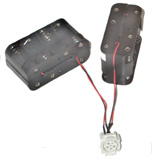 14
June 2004 - It turns out that the springs in the "C" battery
holder used for the test were a problem. They heated to
the point of melting the plastic.
14
June 2004 - It turns out that the springs in the "C" battery
holder used for the test were a problem. They heated to
the point of melting the plastic.
Testing today with a high current modification to one of the
stock 257477BA adapters reduced the total resistance for 10
cells from half an Ohm to less than ¼ Ohm. The half an Ohm
is consistent with the resistance of one battery support
spring. At 3 Amps load the terminal voltage of 10 each 4.5
AH batteries is 12.9 Volts, or 1.29 Volts per cell.
Testing on a real PRC-104 shows the Tx load current to be closer
to 1 Amp than 3 Amps.
14 June 2004 - New idea is to use "AA" cells in a passive
adapter. Home Depot is selling a package of 36
Energizer AAs for $ 13.00. This has a number of big
advantages over any active battery adapter.
C Cell battery Test
13 Aug. 2003 - I'm planning of testing a series
string of 8 Alkaline "C" cells. Rx load will be 200 ma
for 9 minutes and the Tx load will be 3 Amps for 1
minute. This will be repeated untill the voltage drops
below 10.0 Volts.
Brand
|
Duracell
|
Energizer
|
Rayovac
|
Model
|
MN1400
|
E93
|
Maximum Plus
|
Date Code
|
Mar 2010 |
2010
|
Dec 2010
|
Wal Mart
$ for 8 cells
|
$9.74
|
$ 7.97
|
$ 6.84
|
Run Time hrs
|
0 @ 3A
|
no test
|
no test
|
Capacity Amp Hrs
|
|
|
|
Capacity Watt Hrs
|
|
|
|
$ per Watt Hr
|
|
|
|
5590BA15 Active Battery Adapter
This is the 13.6 Volt version. A Switching Mode Power
Supply will take the output from 16 rechargable "C" cells
connected in series and transform it into a 13.6 Volt
output. This way the current draw from the batteries will
be less than the current draw from the radio thus the batteries
will provide more than their nominal watt hours.
5590BA30 Active Battery Adapter
This is the 27.2 Volt version. A Switching Mode
Power Supply will take the output from 16 rechargable "C" cells
connected in series and transform it into a 27.2 Volt
output. There's not enough room inside the BA-5590 outline
to fit more "C" cells.
I need customer data on what radios or other equipment they would
use with either of these adapters. And if the 15 Volt or 30
Volt model and the current pulled from it. The current is a
critical design factor for a SMPS in order to (1) be able to
supply what's needed and (2) do it efficiently.
Links
April 2006 QST article on Green Radios.
Back to Brooke's Products for Sale, Batteries, Military
Information, Home
This is the [an error occurred while processing this directive]
time this page has been accessed since since 27 Feb. 2005.
 The BB-590
battery (shown at left) uses 20 each Sub C (SC) Ni-Cad cells
that have spot welded interconnecting straps. The cells
are held in a plastic two piece calm shell type housing that
provides a small amount of separation between cells.
Label has a 1983 date, 1.5 Amp Hour rating at 1.8 Amps.
So the 2005 SC size RC Ni-MH batteries will probably provide
more than twice the capacity. Even the 2.3 AH Ni-MH AA
cells should have more capacity. Can not test this one
since there are dead cells.
The BB-590
battery (shown at left) uses 20 each Sub C (SC) Ni-Cad cells
that have spot welded interconnecting straps. The cells
are held in a plastic two piece calm shell type housing that
provides a small amount of separation between cells.
Label has a 1983 date, 1.5 Amp Hour rating at 1.8 Amps.
So the 2005 SC size RC Ni-MH batteries will probably provide
more than twice the capacity. Even the 2.3 AH Ni-MH AA
cells should have more capacity. Can not test this one
since there are dead cells. By
hot melt gluing the cells together the resulting pack will be
slightly smaller than the BB-590 pack shown in the photo above
left because the BB-590 has an air gap between cells.
After gluing the copper bars and wires are soldered.
By
hot melt gluing the cells together the resulting pack will be
slightly smaller than the BB-590 pack shown in the photo above
left because the BB-590 has an air gap between cells.
After gluing the copper bars and wires are soldered.







 An old fashioned DC fast charger can be used by
charging each string out of the battery adapter. Note that the
Maha temperature sensor is sandwiched between two of the 3 AA
holders. The stock Maha clip leads work nicely with the Power
Pole connectors on the string of 10 or 11 cells.
An old fashioned DC fast charger can be used by
charging each string out of the battery adapter. Note that the
Maha temperature sensor is sandwiched between two of the 3 AA
holders. The stock Maha clip leads work nicely with the Power
Pole connectors on the string of 10 or 11 cells.

 Two each 5590BA power the
Two each 5590BA power the  In the PRC-215
the battery compartment nearest the electronics is a tight fit but
the other is a good fit. This is a problem with the battery
box, not the 5590BA adapters. To remove the adapter closest
to the electronics the box needs to be turned over and bumped
against your hand.
In the PRC-215
the battery compartment nearest the electronics is a tight fit but
the other is a good fit. This is a problem with the battery
box, not the 5590BA adapters. To remove the adapter closest
to the electronics the box needs to be turned over and bumped
against your hand.



